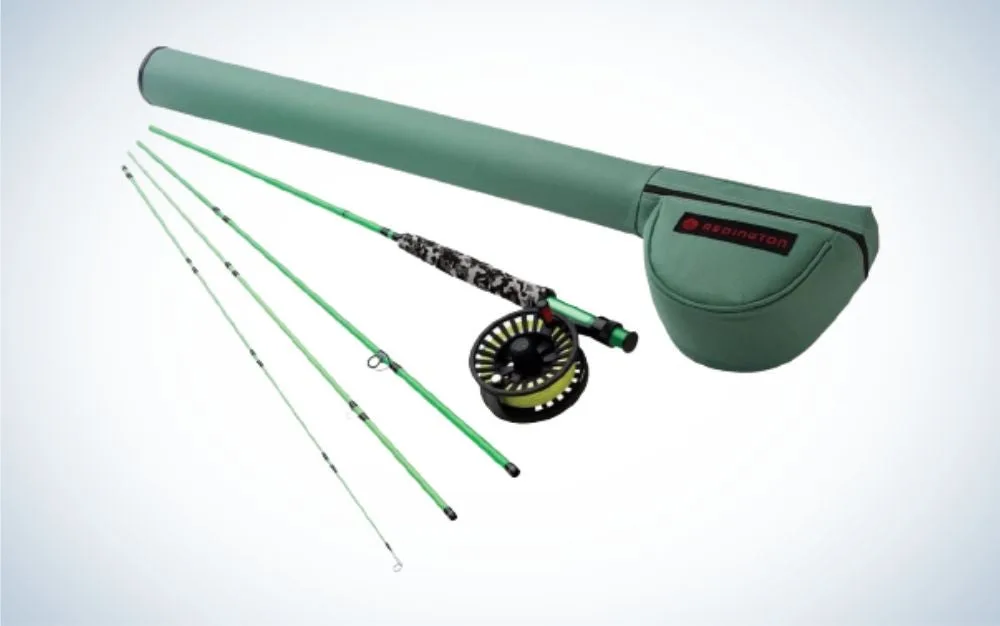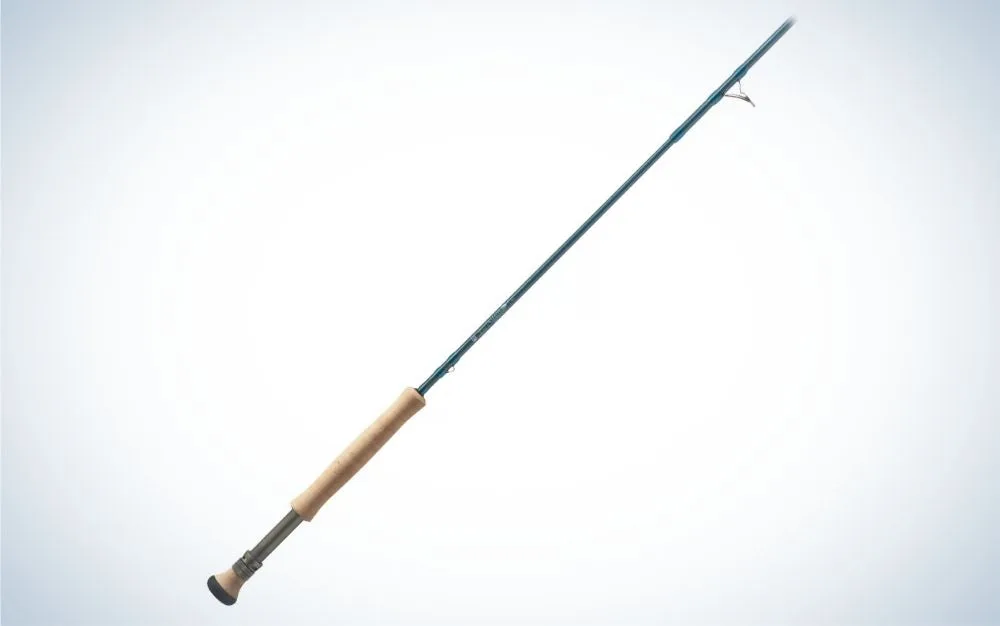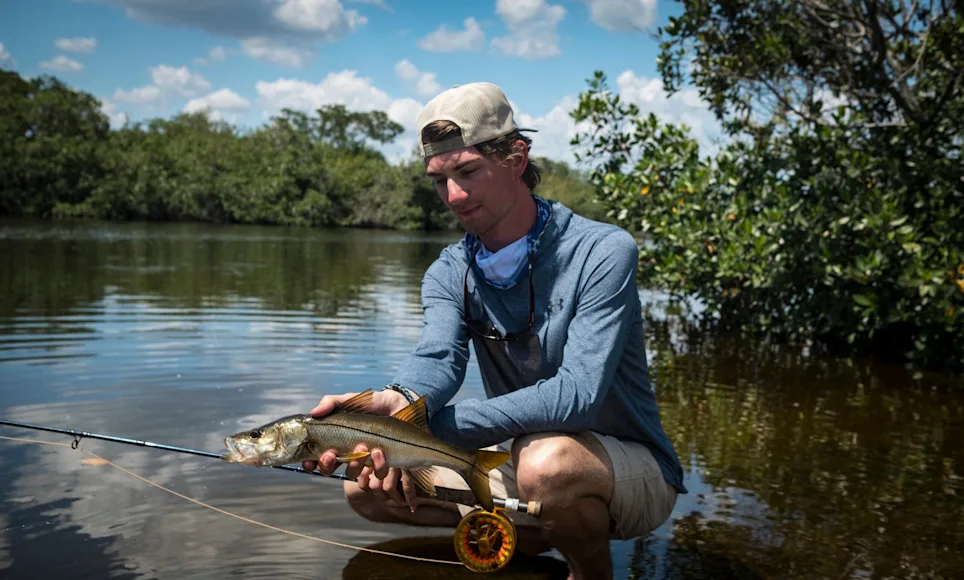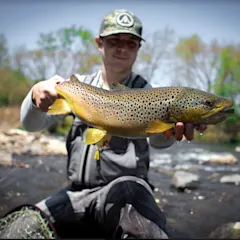_We may earn revenue from the products available on this page and participate in affiliate programs. Learn more ›
_
Best Overall

Orvis Clearwater Combo
LEARN MORE
Summary
The combination of weight, power, and action creates a balanced combo that is easy to learn on.
Best for Kids

Redington Minnow
LEARN MORE
Summary
Durable, easy to cast, and affordable—this rod is great for kids learning to fly fish.
Best for Trout

Greys GR60
LEARN MORE
Summary
The Greys GR60 combines performance and value in this fast-action trout rod.
Fly fishing rods are intimidating for beginners. It’s difficult to decipher between different rod weights, lengths, actions, and brands. On top of that, different species and techniques require specific rods. To minimize confusion, I recommend beginners consider what they fish for and pair a rod accordingly. For trout and small bass, a good 5-weight is a great starting point. Anglers fishing the salt would want an 8-weight to punch through the wind and handle bigger fish. Regardless of what you choose, beginner rods should be forgiving, built to last, and capable of progressing with you. Here are the best fly fishing rods for beginners available now.
Best Overall: Orvis Clearwater Combo
Best for Kids: Redington Minnow
Best for Trout: Greys GR60
Best for Saltwater: St. Croix Imperial Salt
Best for Steelhead: Redington Dually
How We Picked The Best Fly Fishing Rods for Beginners
I am a self-taught fly angler and still find plenty of things to improve upon in my casting technique. I find that having a rod you’re comfortable with is critical to making a good cast. There are also plenty of resources out there to learn the different rigs, what flies to use, and how to cast. If you are fortunate enough to have a local Trout Unlimited club, attend a meeting. There is no shortage of knowledgeable and willing people that can help you. When it comes to picking out a rod for the first time look for something that feels right to you. Here are the criteria I based my selections on:
Components: Are the reel seats, guides, and handles good quality?
Action: How does the action feel when casting?
Durability: Is the rod prone to breaking?
Warranty: What warranty does the rod have in case it breaks?
Available Configurations: What rod lengths and weights are available for each model?
The Best Fly Fishing Rods for Beginners: Reviews & Recommendations
Best Overall: Orvis Clearwater Outfit
Best Combo

Why it Made the Cut: The combination of weight, power, and action creates a balanced combo that is easy to learn on.
Key Features
Rod Length: 9 feet
Rod Weight: 5wt
Action: Medium-fast
Pros:
Fully rigged and ready to fish
Forgiving and powerful rod action
Easy to cast
25-year warranty
Cons:
Pricier than other combos
The Orvis Clearwater took home the Best Value award in our recent fly rod test
on the Delaware River. It’s built on a medium-fast action blank that’s powerful and forgiving. On a back cast, you can feel the tip section load indicating you can begin your forward cast. This feedback helps new anglers learn to time their cast. The Clearwater’s action also contributes to fighting fish. I’ve seen a lot of beginners break off fish because their drag is set too tight. The softer tip section protects lighter tippets giving you a chance to loosen the drag. Orvis paired the outfit with a large arbor Clearwater reel. The drag system is easy to fine-tune and has low startup inertia. This means as soon as the fish pulls the drag engages. As an outfit, it comes rigged with backing, a fly line, and a leader. Add in a 25-year, no question asked warranty and this combo will be there throughout your angling career.
Best for Kids: Redington Minnow
Best for Kids

Why it Made the Cut: Durable, easy to cast, and affordable—this rod is great for kids learning to fly fish.
Key Features
Rod Length: 8ft
Rod Weight: 5wt
Action: Moderate
Pros:
Medium action is easy to cast
The 8-foot rod is sized right for kids
Can withstand abuse
Cons:
1-year warranty
Teach your kids to fly fish (and keep your gear safe) with the Redington Minnow fly rod. It’s an 8-foot, 5-weight and designed with kids in mind. Shortening the rod reduces swing weight and allows smaller anglers to stop the rod at the end of a cast. A firm stop is key to rolling the fly line out in a tight loop. They paired this with a moderate action to further aid in casting. For kids, this helps them slow down and focus on the casting motion. I’ve also found moderate action rods can take plenty of abuse especially when kids are involved. When they are ready to hit the water this rod handles fish well. The 5-weight spine has plenty of power to turn big fish and the softer blank protects your tippet. At 8 feet, it is sized right so that kids can grow with the rod as they get older. It is available as a stand-alone rod or as a rod and reel combo.
Best for Trout: Greys GR60
Best for Trout

Why it Made the Cut: The Greys GR60 combines performance and value in this fast-action trout rod.
Key Features
Rod Length: 9 feet
Rod Weight: 5wt
Action: Fast
Pros:
Solid reel seat
Fast action blank
Affordable
Cons:
Some prefer snake guides
While the fast-action rod trend has captured the industry, finding a budget-friendly option is still surprisingly hard. Most affordable rods are heavy and stiff to give them the fast action feel. The Greys GR60 takes a different approach using Toreon nano-blank technology. This maximizes the strength-to-weight ratio for a lightweight fast action trout rod. Greys is a sister company to Hardy and the quality of this rod shows that. The machined aluminum reel seat, AAA grade cork, oversized guides, and section line-up markers are typically only found on higher-end rods. On the water, it’s lightweight but well-balanced to avoid casting fatigue. I paired mine with a 5-weight reel and a weight-forward 5-weight line. This setup delivers accurate casts in a variety of situations. I fish heavy nymph rigs, dry flies, and small streamers with no issues. Despite being fast, the tip section provides anglers with ample feedback when fighting a fish. The GR60s performance is unmatched in the entry-level price market.
Best for Saltwater: St. Croix Imperial Salt
Best for Saltwater

Why it Made the Cut: A powerful saltwater rod that promotes proper casting technique for beginners.
Key Features
Rod Length: 9 feet
Rod Weight: 8wt
Action: Medium-fast
Pros:
Solid fish fighting backbone
Corrosion-resistant guides and reel seat
Easy casting stroke
Cons:
Slightly more expensive than others
Saltwater fly fishing presents a unique set of challenges. Stiff headwinds, fast fish, and accurate casts humble the best anglers. The St. Croix Imperial Salt helps counter these conditions. It has a corrosion-resistant coating on all metal components to prevent rust and a strong backbone to fight big fish. The 9-foot, 8-weight model is a good all-around rod for bonefish, snook, stripers, and redfish. A medium-fast action is my ideal choice for new saltwater anglers. This action has more bend during the cast which helps you feel the rod load. Timing this right results in further and more accurate casts. Plus, the butt section still has plenty of power to tire out bigger fish. Add the 15-year warranty and this rod will be a staple in your arsenal.
Best for Steelhead: Redington Dually
Best for Steelhead

Why it Made the Cut: An affordable two-handed rod that can swing flies, drift beads, high-stick nymphs.
Key Features
Rod Length: 11 feet, 6 inches
Rod Weight: 7wt
Action: Medium-fast
Pros:
Affordable
Powerful fish fighting ability
Easy to cast
Cons:
Pairing the proper line can be confusing
Any angler fortunate enough to fish for steelhead knows the struggle. One day they might crush a swung fly and the next all they want is egg flies. The Redington Dually is an 11-foot 6-inch switch rod that can cover any steelhead scenario. When fished like a single-hand rod the added length lets you mend the line further away which results in better drifts. I typically fish a weight-forward 7-weight line for extra sensitivity. This is my preferred technique for fishing egg flies or nymphs. If you do hook a fish, the two-handed handle lets you dig the rod butt into your side for more control. Now, swinging flies is a bit more complicated. I’ve found pairing this rod with a short Skagit head is the easiest way to learn. With a Snap-T and a Double Spey cast, you can swing flies in any type of current. The solid warranty and the affordable price make this a great option for anglers wanting to try swinging but is also there when it’s time to tie on an egg.
Things to Consider Before Buying The Best Fly Fishing Rods for Beginners
At all price points, rods vary in quality and performance. Recognizing what components make a solid fly rod can help you get the most out of your purchase. I look for durable materials, good action, and the right length for the species I’m targeting.
Components
Fly rods feature three main components—guides, cork (the handle), and the reel seat. The reel seat is the most important indicator of overall quality and comfort. Good reel seats are machined out of aluminum with a locking system to keep your reel secure. If the reel seat can’t keep the reel in place, you’ll be frustrated and most likely lose fish. A well-made rod will feature oversized snake guides and one or two stripping guides. Companies like Snake Brand or Fuji are solid choices for their durability and performance. The handle is a vital part of your fly rod and quality cork should have no imperfections. Look for little bubbles or holes in the cork—this indicates poor materials that won’t last.
Rod Action
Modern fly rods get faster and faster each year. While this is great for casting a fly through a stiff headwind, it’s not great for beginners. I recommend a medium or medium-fast action rod for those starting. A medium-action rod helps anglers slow down their casting stroke and get the feel for false casting. You should feel the rod load throughout the blank which results in further and more accurate casts. Medium-fast actions are another alternative. They still let you feel the rod load and have a stiffer backbone for windy days.
Rod Length
Fly rods vary anywhere from 6 to 14 feet in length, but my go-to length has always been 9 feet. Regardless of species, this length offers the best in casting distance, line control, and accuracy.
On a trout stream, you can make precise casts and still mend lines throughout the drift.
In saltwater, a 9-foot rod offers the same accuracy and power to drop a fly in front of cruising fish. While everyone has their preferences, the versatility of a 9-foot rod is great for anglers just starting.
FAQs
Q: What length fly rod is best for beginners?
I recommend beginners fish a 9-foot fly rod. This length offers the best combination of accuracy, casting distance, and line control. You can pick up and mend lines or shoot casts across a stream. This length performs well on any weight fly rod. From 4-weight trout rods to 12-weight tarpon rods—9 feet is my preferred length.
Q: How to balance a fly rod and reel?
Balancing a rod and reel is simple. I prefer to try different reels at the store to find what fits the best. The combo should balance out somewhere near the front of the cork. This minimizes the amount of fatigue you get from casting. All reels vary in size and weight so trying them on a rod in person is important.
Q: What is a 5-weight fly rod good for?
Five-weight rods are the most versatile rods out there. For trout fishing, you can fish nymph rigs, big dries, and streamers. They also have plenty of backbone to make further casts and handle bigger fish. This transfers well to warm water fishing. Bass and panfish anglers like 5-weights as a lightweight option that can cast bigger bugs and poppers. I’ve even heard of some anglers catching smaller saltwater fish with a 5-weight in a pinch.
Final Thoughts on the Best Fly Fishing Rods for Beginners
I know how confusing it is to learn to fly fish. Start by looking for rods with quality components, a medium-fast action, and the right length for you. My best advice is to go with the rod that feels the best and is in your budget. The more you practice the better you’ll get. If you don’t have access to water, practice casting on a grassy field to get some experience. A good fly rod is the foundation of your casting and success on the water.
Why Trust Us
For more than 125 years, Field & Stream has been providing readers with honest and authentic coverage of outdoor gear. Our writers and editors eat, sleep, and breathe the outdoors, and that passion comes through in our product reviews. You can count on F&S to keep you up to date on the best new gear. And when we write about a product—whether it’s a bass lure or a backpack—we cover the good and the bad, so you know exactly what to expect before you decide to make a purchase.






